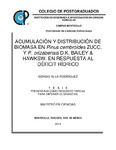| dc.description.abstract | Se determinó la resistencia a sequía de Pinus cembroides y P. orizabensis y el efecto del déficit de humedad en la resistencia a bajas temperaturas, la longitud de acículas y la densidad de estomas. Se utilizaron plantas de 16 meses de edad de tres procedencias de cada especie. Se estableció un experimento con dos niveles de humedad que duró 11 meses. Tubos de PVC de 10 cm de diámetro por 100 cm de longitud se usaron como macetas. La humedad del sustrato fluctuó de 45 a 38 % en S0 (riego) y de 36 a 30 % en S1 (sequía). En S1 el incremento de altura, diámetro y longitud de raíz y el número total de ramas fue menor en 20, 46, 30 y 31.2 %, respectivamente, que en S0. Se redujo la acumulación de biomasa aérea, del tallo, acículas, ramas y raíz en un 32, 43, 26, 33 y 50 %, respectivamente, mientras que la relación de biomasa aérea/radical aumentó 33 %. En S0, P. cembroides presentó mayor proporción de plantas con hojas secundarias (79.5 vs. 66 %), biomasa de tallo (6 vs. 5.18 g) y de raíz (12.9 vs. 10.2 g) que P. orizabensis. En sequía, P. cembroides tuvo mayor incremento en diámetro (3.26 vs. 2.76 mm), número de ramas (8.0 vs. 5.8), biomasa de ramas (0.99 vs. 0.84 g) y de raíz (6.34 vs. 5.20 g) que P. orizabensis. La relación biomasa parte aérea/raíz resultó 21 y 12 % mayor en P. orizabensis en riego y sequía, respectivamente. Entre procedencias hubo diferencias en todas las variables. En la primera prueba (en invierno) de la resistencia a bajas temperaturas, el índice de daño (ID) fue 16.6 % mayor en las plantas bajo sequía; el ID aumentó 18 % en P. cembroides y 15 % en P. orizabensis. En una segunda prueba el ID fue 12 % mayor en S1; el aumento entre la primera y segunda fue de 11.6% en S0 y de 7% en S1. En la tercera prueba se encontró también un efecto negativo del estrés hídrico, pero solo diferencias significativas entre los estados fenológicos en las plantas bajo riego (55.7 % de daño en las plantas en elongación y 41.6 % en las plantas con yemas en reposo). La procedencia de Colón de P. cembroides, menos dañada en las primeras pruebas, fue igual de sensible que la de Tepeyahualco de P. orizabensis; sin embargo, en sequía, las de Colón que formaron yema terminal fueron más tolerantes que las de Tepeyahualco, pero lo contrario en las plantas que no formaron yema. El tratamiento de S1 impuesto disminuyó el tamaño del estoma en 11.7 % y la longitud de la acícula en 23 %, lo que incremento en 14 % la densidad estomatal por mm lineal. El efecto de la sequía impuesto en las acículas y estomas fue similar entre las dos especies y las seis procedencias probadas. _______________ ACCUMULATION AND DISTRIBUTION OF BIOMASS IN Pinus cembroides ZUCC. AND P. orizabensis D.K. BAILEY & HAWKSW. IN RESPONSE TO THE WATER DEFICIT. ABSTRACT: Drought resistance of Pinus cembroides and P. orizabensis, and the effects of water deficit on the resistance to low temperatures needle length and stomata density were determined. Plants of 16 months of age from three provenances of each pine were used. An experiment was established with two humidity levels that lasted 11 months. PVC tubes of 10 cm diameter by 100 cm length were used as pots. The humidity of the substrate fluctuated from 45 to 38 % in S0 (control, normal irrigation) and from 36 to 30 % in S1 (water deficit). In S1 the increment in height, diameter and root length and the total number of branches were 20, 46, 30 and 31.2 % lower, respectively, than in S0. Aerial, stem, needles, branches and root biomass accumulation was reduced by 32, 43, 26, 33 and 50 %, respectively, whereas the ratio of aerial / root biomass increased 33 %. In S0, P. cembroides presented a higher proportion of seedlings with secondary needles (79.5 vs. 66 %), stem (6 vs. 5.18 g) and root biomass (12.9 vs. 10.2 g) than P. orizabensis. In drought, P. cembroides had greater increase in diameter (3.26 vs. 2.76 mm), number of branches (8.0 vs. 5.8), branch (0.99 vs. 0.84 g) and root biomass (6.34 vs. 5.20 g) than P. orizabensis. The aerial / root biomass ratio was 21 and 12 % higher in P. orizabensis in control and in drought, respectively. There were differences in all the variables among provenances. In the winter test of resistance to low temperature, the damage index (DI) was 16.6% higher in plants under drought; DI increased 18% in P. cembroides and 15 % in P. orizabensis. In a second test DI was 12 % higher in S1, and DI increased by 11.6 % in S0 and 7 % in S1 when compared with the first test. In the third test, a negative effect of the drought stress was found, but there were only significant differences among the phenological stages in S0, 55.7 % in elongation to 41.6 % when plants were in dormancy. The Colón provenance of P. cembroides, less damaged in the initial tests, was as sensible as the Tepeyahualco of P. orizabensis; however, in drought, seedling from Colón with developed bud were more tolerant than those from Tepeyahualco but the opposite occurred in seedlings with no bud development. The S1 treatment decreased stomata length by 11.7 % and needle length by 23%, which increased stomata density per mm by 14 %. The effect of the imposed drought in the needles and stomata was similar among the two pinyon pines and the six tested provenances. | es_MX |


